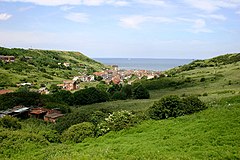Skinningrove
| Skinningrove | |
|---|---|
 |
|
| Skinningrove shown within North Yorkshire | |
| Population | 460 |
| OS grid reference | NZ711199 |
| Unitary authority | |
| Ceremonial county | |
| Region | |
| Country | England |
| Sovereign state | United Kingdom |
| Post town | REDCAR |
| Postcode district | TS13 |
| Police | Cleveland |
| Fire | Cleveland |
| Ambulance | North East |
| EU Parliament | North East England |
| UK Parliament | |
Skinningrove is a village in North Yorkshire, England. Its name is Viking influenced and is thought to mean Skinners' grove or pit.
The village had an agricultural and fishing economy until the opening of local ironstone workings in 1848 initiated an industrialisation boom. A railway was built by 1865, and iron smelting began in 1874. A jetty on the coast built in 1880 allowed seagoing vessels to carry heavy cargoes from the area. Mining continued until 1958 and primary iron production until the 1970s.
The Cleveland Ironstone Mining Museum (formerly the Tom Leonard Mining Museum) describes the village's mining heritage, providing a unique underground experience and an insight into how 6.2 million tons of ironstone was extracted from Skinningrove. The village has a large natural sand beach used for recreational fishing and a beck, which occasionally floods, notably in the year 2000. It also has the Riverside Building community centre which is on the site of a former school. There is a Methodist chapel which has services on a Sunday at 18:00. There is also a fish and chip shop, a community centre and general dealers and post office. Every year Skinningrove hosts a bonfire and fireworks display which attracts hundreds of people from around North Yorkshire. Each year the bonfire is based on a different theme. The Cleveland Way runs through the village.
On 17 February 2003, a rarely seen oarfish was caught by angler Val Fletcher, using a fishing rod baited with squid. The fish was 11 ft 4in (3.3 metres) long and weighed 140 lb (63.5 kg). Graham Hill, the science officer at The Deep, an aquarium in Kingston upon Hull, said that he had never heard of another oarfish being caught off the coast of Britain. The Natural History Museum in London said that it would have been interested in preserving the fish in its permanent collection; however the fish had been 'cut up into steaks' before any scientists could examine it.
...
Wikipedia

